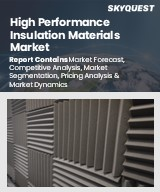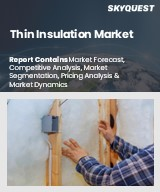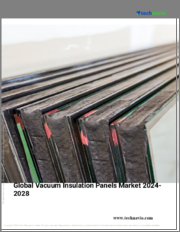
|
시장보고서
상품코드
1702079
진공 단열 패널(VIP) 시장 보고서 : 유형, 원재료, 코어 재료, 용도, 지역별(2025-2033년)Vacuum Insulation Panel Market Report by Type, Raw Material, Core Material, Application, and Region 2025-2033 |
||||||
IMARC Group은 2024년 진공 단열 패널(VIP) 세계 시장 규모가 95억 달러에 이르렀으며, 2025-2033년 4.1%의 연평균 성장률(CAGR)로 2033년에는 136억 달러에 달할 것으로 예측했습니다. 지속 가능한 건축 관행에 대한 인식 증가, 에너지 효율을 촉진하는 엄격한 규제, 제조 기술 발전, 콜드체인 물류에 대한 수요 증가, 전기자동차로의 전환, 모듈 건축 트렌드, 제약 산업의 괄목할만한 성장 등은 시장의 밝은 전망을 만드는 요인 중 일부입니다.
진공 단열 패널(VIP)은 대기압에 의한 외부 하중을 견딜 수 있는 개방형 다공성 코어 재료와 필요한 진공 품질을 유지하기 위한 기밀성 외피로 구성된 평판 요소입니다. 장시간 사용 및 고온 등 열에 민감한 제품을 열악한 조건에서 운송하는 데 적합합니다. 단열재의 두께가 얇고 고성능 단열재입니다. 그 결과, VIP는 전 세계 건설 산업 및 물류 산업에서 널리 사용되고 있습니다.
진공 단열 패널(VIP) 시장 동향 :
최근 동향 : 나노기술과 재료과학의 눈부신 발전으로 알려진 열물리학의 이론적 원리를 실제로 적용하는 것이 가능해지면서 고성능 단열재 개발이 진행되고 있습니다. 이는 세계의 급속한 산업화와 도시화에 따른 건설 활동 증가와 함께 시장 성장을 가속하는 중요한 요인 중 하나가 되고 있습니다. 또한, VIP는 단독주택, 공동주택, 보육원, 오피스 빌딩의 신축 및 개축 시 외단열재 및 내단열재로 사용됩니다. 또한 바닥, 파사드, 파사드, 평지붕, 테라스, 벽, 다락방 해치, 계단 단열에도 이용됩니다. 이 외에도 냉장 트럭 및 운송 시스템, 자동판매기, 냉장고, 냉동고, 와인 쿨러 등의 저온 저장 장치, 의료품 및 의약품 포장에도 사용됩니다. 또한 VIP는 가정용 오븐, 용광로, 용광로, 온수 탱크, 집광형 태양광 발전소 등 고온 응용 분야, 특히 내열성 유리 섬유 코어 패널에 적합합니다. 이 외에도 VIP는 기존 단열 패널보다 우수한 단열 성능을 보여 시장 성장을 가속하고 있습니다. 또한, 전 세계 저온 저장 시설의 급속한 확장은 시장에 긍정적인 영향을 미치고 있습니다.
본 보고서에서 다룬 주요 질문
- 2024년 세계 진공 단열 패널(VIP) 시장 규모는?
- 2025-2033년 세계 진공 단열 패널(VIP) 시장의 예상 성장률은?
- 세계 진공 단열 패널(VIP) 시장을 이끄는 주요 요인은?
- 코로나19가 세계 진공 단열 패널(VIP) 시장에 미치는 영향은?
- 세계 진공 단열 패널(VIP) 시장의 유형별 분류는?
- 세계 진공 단열 패널(VIP) 시장의 심재별 시장 현황은?
- 세계 진공 단열패널 시장의 용도별 시장 현황은?
- 세계 진공 단열 패널(VIP) 시장의 주요 지역은?
- 세계 진공 단열 패널(VIP) 시장의 주요 기업은?
목차
제1장 서문
제2장 조사 범위와 조사 방법
- 조사 목적
- 이해관계자
- 데이터 소스
- 1차 정보
- 2차 정보
- 시장 추정
- 보텀업 접근
- 톱다운 접근
- 조사 방법
제3장 주요 요약
제4장 서론
- 개요
- 주요 업계 동향
제5장 세계의 진공 단열 패널(VIP) 시장
- 시장 개요
- 시장 실적
- COVID-19의 영향
- 시장 예측
제6장 시장 분석 : 유형별
- 플랫 패널
- 특수 패널
제7장 시장 분석 : 원재료별
- 플라스틱
- 금속
제8장 시장 분석 : 코어 재료별
- 실리카
- 유리섬유
- 기타
제9장 시장 분석 : 용도별
- 건설
- 냉각 및 냉동 장비
- 물류
- 기타
제10장 시장 분석 : 지역별
- 북미
- 미국
- 캐나다
- 아시아태평양
- 중국
- 일본
- 인도
- 한국
- 호주
- 인도네시아
- 기타
- 유럽
- 독일
- 프랑스
- 영국
- 이탈리아
- 스페인
- 러시아
- 기타
- 라틴아메리카
- 브라질
- 멕시코
- 기타
- 중동 및 아프리카
- 시장 내역 : 국가별
제11장 SWOT 분석
- 개요
- 강점
- 약점
- 기회
- 위협
제12장 밸류체인 분석
제13장 Porter의 Five Forces 분석
- 개요
- 바이어의 교섭력
- 공급 기업의 교섭력
- 경쟁 정도
- 신규 진출업체의 위협
- 대체품의 위협
제14장 가격 분석
제15장 경쟁 구도
- 시장 구조
- 주요 기업
- 주요 기업 개요
- Avery Dennison Corporation
- BASF SE
- Etex Building Performance NV(Etex Group)
- Evonik Industries AG(RAG-Stiftung)
- Kevothermal Ltd
- Kingspan Group plc
- Knauf Insulation
- Morgan Advanced Materials
- OCI Company Ltd.
- Panasonic Corporation
- TURNA d.o.o.
- Va-Q-Tec AG
The global vacuum insulation panel market size reached USD 9.5 Billion in 2024. Looking forward, IMARC Group expects the market to reach USD 13.6 Billion by 2033, exhibiting a growth rate (CAGR) of 4.1% during 2025-2033. The increasing awareness of sustainable building practices, stringent regulations promoting energy efficiency, advancements in manufacturing technologies, rising demand for cold chain logistics, the shift towards electric vehicles, the trend of modular construction, and the significant growth in the pharmaceutical industry are some of the factors creating a positive outlook for the market.
A vacuum insulation panel (VIP) is a flat element comprising an open porous core material, which withstands the external load caused by atmospheric pressure and a gas-tight envelope to maintain the required quality of the vacuum. It is ideal for the transportation of heat-sensitive products in extreme conditions, such as prolonged periods and intense temperatures. It offers low insulation thickness and high-performance thermal insulation. As a result, VIP finds extensive applications in the construction and logistics industries across the globe.
Vacuum Insulation Panel Market Trends:
In recent years, significant progress in nanotechnology and material sciences, allowing the adaptation of known theoretical principles of thermal physics in practice, has resulted in the development of high-performance thermal insulators. This, in confluence with increasing construction activities on account of rapid industrialization and urbanization across the globe, represents one of the key factors bolstering the growth of the market. Moreover, VIPs are used as external or internal insulation in detached houses, apartment buildings, nurseries, and office buildings in new construction and renovations. They are also utilized for insulating floors, facades, flat roofs, terraces, walls, attic hatches, and stairs. Apart from this, they are used in refrigerated trucks and transportation systems, vending machines, cold storage units like fridges, freezers, and wine coolers, and packaging for medical and pharmaceutical products. In addition, VIPs are viable for high-temperature applications, such as domestic ovens, furnaces, hot water tanks, and concentrated solar plants, especially with heat-resistant glass-fiber core panels. Besides this, VIPs exhibit superior insulation performance than conventional insulating panels, which is impelling the growth of the market. Furthermore, the rapid expansion of cold storage facilities worldwide is positively influencing the market.
Key Market Segmentation:
Breakup by Type:
- Flat Panel
- Special Shape Panel
Breakup by Raw Material:
- Plastics
- Metal
Breakup by Core Material:
- Silica
- Fiberglass
- Others
Breakup by Application:
- Construction
- Cooling and Freezing Devices
- Logistics
- Others
Breakup by Region:
- North America
- United States
- Canada
- Asia-Pacific
- China
- Japan
- India
- South Korea
- Australia
- Indonesia
- Others
- Europe
- Germany
- France
- United Kingdom
- Italy
- Spain
- Russia
- Others
- Latin America
- Brazil
- Mexico
- Others
- Middle East and Africa
Competitive Landscape:
The competitive landscape of the industry has also been examined along with the profiles of the key players being Avery Dennison Corporation, BASF SE, Etex Building Performance NV (Etex Group), Evonik Industries AG (RAG-Stiftung), Kevothermal Ltd, Kingspan Group plc, Knauf Insulation, Morgan Advanced Materials, OCI Company Ltd., Panasonic Corporation, TURNA d.o.o. and Va-Q-Tec AG.
Key Questions Answered in This Report
- 1.What was the size of the global vacuum insulation panel market in 2024?
- 2.What is the expected growth rate of the global vacuum insulation panel market during 2025-2033?
- 3.What are the key factors driving the global vacuum insulation panel market?
- 4.What has been the impact of COVID-19 on the global vacuum insulation panel market?
- 5.What is the breakup of the global vacuum insulation panel market based on the type?
- 6.What is the breakup of the global vacuum insulation panel market based on the core material?
- 7.What is the breakup of the global vacuum insulation panel market based on the application?
- 8.What are the key regions in the global vacuum insulation panel market?
- 9.Who are the key players/companies in the global vacuum insulation panel market?
Table of Contents
1 Preface
2 Scope and Methodology
- 2.1 Objectives of the Study
- 2.2 Stakeholders
- 2.3 Data Sources
- 2.3.1 Primary Sources
- 2.3.2 Secondary Sources
- 2.4 Market Estimation
- 2.4.1 Bottom-Up Approach
- 2.4.2 Top-Down Approach
- 2.5 Forecasting Methodology
3 Executive Summary
4 Introduction
- 4.1 Overview
- 4.2 Key Industry Trends
5 Global Vacuum Insulation Panel Market
- 5.1 Market Overview
- 5.2 Market Performance
- 5.3 Impact of COVID-19
- 5.4 Market Forecast
6 Market Breakup by Type
- 6.1 Flat Panel
- 6.1.1 Market Trends
- 6.1.2 Market Forecast
- 6.2 Special Shape Panel
- 6.2.1 Market Trends
- 6.2.2 Market Forecast
7 Market Breakup by Raw Material
- 7.1 Plastics
- 7.1.1 Market Trends
- 7.1.2 Market Forecast
- 7.2 Metal
- 7.2.1 Market Trends
- 7.2.2 Market Forecast
8 Market Breakup by Core Material
- 8.1 Silica
- 8.1.1 Market Trends
- 8.1.2 Market Forecast
- 8.2 Fiberglass
- 8.2.1 Market Trends
- 8.2.2 Market Forecast
- 8.3 Others
- 8.3.1 Market Trends
- 8.3.2 Market Forecast
9 Market Breakup by Application
- 9.1 Construction
- 9.1.1 Market Trends
- 9.1.2 Market Forecast
- 9.2 Cooling and Freezing Devices
- 9.2.1 Market Trends
- 9.2.2 Market Forecast
- 9.3 Logistics
- 9.3.1 Market Trends
- 9.3.2 Market Forecast
- 9.4 Others
- 9.4.1 Market Trends
- 9.4.2 Market Forecast
10 Market Breakup by Region
- 10.1 North America
- 10.1.1 United States
- 10.1.1.1 Market Trends
- 10.1.1.2 Market Forecast
- 10.1.2 Canada
- 10.1.2.1 Market Trends
- 10.1.2.2 Market Forecast
- 10.1.1 United States
- 10.2 Asia-Pacific
- 10.2.1 China
- 10.2.1.1 Market Trends
- 10.2.1.2 Market Forecast
- 10.2.2 Japan
- 10.2.2.1 Market Trends
- 10.2.2.2 Market Forecast
- 10.2.3 India
- 10.2.3.1 Market Trends
- 10.2.3.2 Market Forecast
- 10.2.4 South Korea
- 10.2.4.1 Market Trends
- 10.2.4.2 Market Forecast
- 10.2.5 Australia
- 10.2.5.1 Market Trends
- 10.2.5.2 Market Forecast
- 10.2.6 Indonesia
- 10.2.6.1 Market Trends
- 10.2.6.2 Market Forecast
- 10.2.7 Others
- 10.2.7.1 Market Trends
- 10.2.7.2 Market Forecast
- 10.2.1 China
- 10.3 Europe
- 10.3.1 Germany
- 10.3.1.1 Market Trends
- 10.3.1.2 Market Forecast
- 10.3.2 France
- 10.3.2.1 Market Trends
- 10.3.2.2 Market Forecast
- 10.3.3 United Kingdom
- 10.3.3.1 Market Trends
- 10.3.3.2 Market Forecast
- 10.3.4 Italy
- 10.3.4.1 Market Trends
- 10.3.4.2 Market Forecast
- 10.3.5 Spain
- 10.3.5.1 Market Trends
- 10.3.5.2 Market Forecast
- 10.3.6 Russia
- 10.3.6.1 Market Trends
- 10.3.6.2 Market Forecast
- 10.3.7 Others
- 10.3.7.1 Market Trends
- 10.3.7.2 Market Forecast
- 10.3.1 Germany
- 10.4 Latin America
- 10.4.1 Brazil
- 10.4.1.1 Market Trends
- 10.4.1.2 Market Forecast
- 10.4.2 Mexico
- 10.4.2.1 Market Trends
- 10.4.2.2 Market Forecast
- 10.4.3 Others
- 10.4.3.1 Market Trends
- 10.4.3.2 Market Forecast
- 10.4.1 Brazil
- 10.5 Middle East and Africa
- 10.5.1 Market Trends
- 10.5.2 Market Breakup by Country
- 10.5.3 Market Forecast
11 SWOT Analysis
- 11.1 Overview
- 11.2 Strengths
- 11.3 Weaknesses
- 11.4 Opportunities
- 11.5 Threats
12 Value Chain Analysis
13 Porters Five Forces Analysis
- 13.1 Overview
- 13.2 Bargaining Power of Buyers
- 13.3 Bargaining Power of Suppliers
- 13.4 Degree of Competition
- 13.5 Threat of New Entrants
- 13.6 Threat of Substitutes
14 Price Analysis
15 Competitive Landscape
- 15.1 Market Structure
- 15.2 Key Players
- 15.3 Profiles of Key Players
- 15.3.1 Avery Dennison Corporation
- 15.3.1.1 Company Overview
- 15.3.1.2 Product Portfolio
- 15.3.1.3 Financials
- 15.3.1.4 SWOT Analysis
- 15.3.2 BASF SE
- 15.3.2.1 Company Overview
- 15.3.2.2 Product Portfolio
- 15.3.2.3 Financials
- 15.3.2.4 SWOT Analysis
- 15.3.3 Etex Building Performance NV (Etex Group)
- 15.3.3.1 Company Overview
- 15.3.3.2 Product Portfolio
- 15.3.4 Evonik Industries AG (RAG-Stiftung)
- 15.3.4.1 Company Overview
- 15.3.4.2 Product Portfolio
- 15.3.4.3 Financials
- 15.3.4.4 SWOT Analysis
- 15.3.5 Kevothermal Ltd
- 15.3.5.1 Company Overview
- 15.3.5.2 Product Portfolio
- 15.3.6 Kingspan Group plc
- 15.3.6.1 Company Overview
- 15.3.6.2 Product Portfolio
- 15.3.6.3 Financials
- 15.3.6.4 SWOT Analysis
- 15.3.7 Knauf Insulation
- 15.3.7.1 Company Overview
- 15.3.7.2 Product Portfolio
- 15.3.8 Morgan Advanced Materials
- 15.3.8.1 Company Overview
- 15.3.8.2 Product Portfolio
- 15.3.8.3 Financials
- 15.3.9 OCI Company Ltd.
- 15.3.9.1 Company Overview
- 15.3.9.2 Product Portfolio
- 15.3.9.3 Financials
- 15.3.9.4 SWOT Analysis
- 15.3.10 Panasonic Corporation
- 15.3.10.1 Company Overview
- 15.3.10.2 Product Portfolio
- 15.3.10.3 Financials
- 15.3.10.4 SWOT Analysis
- 15.3.11 TURNA d.o.o.
- 15.3.11.1 Company Overview
- 15.3.11.2 Product Portfolio
- 15.3.12 Va-Q-Tec AG
- 15.3.12.1 Company Overview
- 15.3.12.2 Product Portfolio
- 15.3.12.3 Financials
- 15.3.1 Avery Dennison Corporation



















